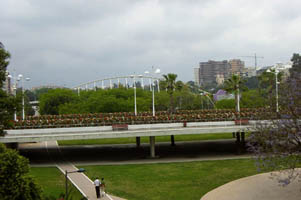
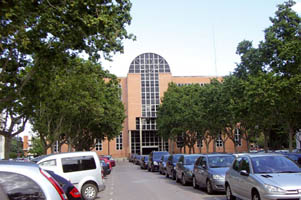
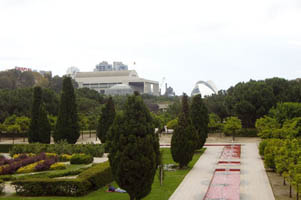
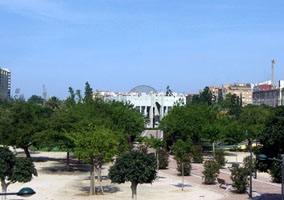
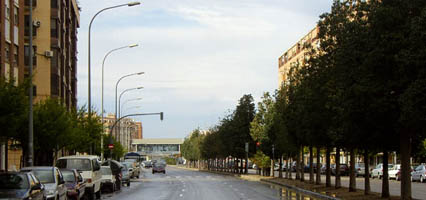
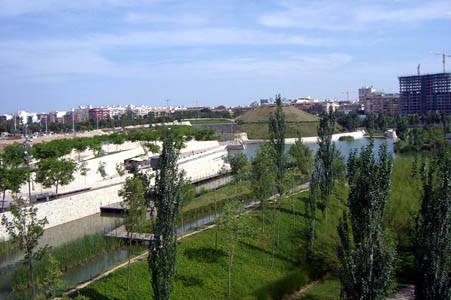
|
|
| Mercedes Planelles Herrero |
| “Una Valencia global” |
  
|
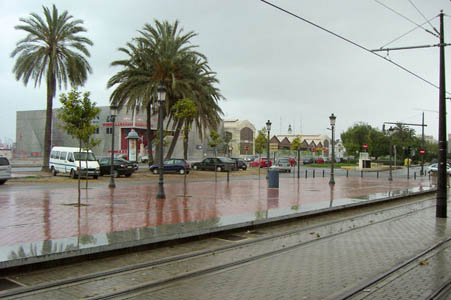 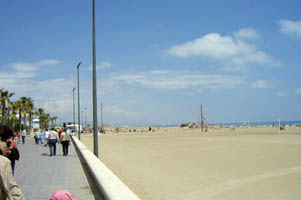
|
|
| Aprovechando
este número dedicado a la arquitectura reciente en la provincia, se hace
un breve recorrido por las actuaciones y obras realizadas en la ciudad de
Valencia que han dado como resultado la ciudad que hoy conocemos y que
poco tiene que ver con la capital de provincias de los años 70.
Aunque la transformación sufrida por Valencia en los últimos 30 años se ha hecho evidente al mundo con la difusión de su nueva imagen por últimos eventos de los que ha sido sede: encuentro de familias, 32 Copa de la América, presentación de Mclaren-Mercedes y el Gran Premio de Europa de Formula 1. El germen está en la década de los 80 como consecuencia del cambio político en España y el desarrollo del estado de las autonomías. La descentralización y desconcentración administrativa produce una intensa actividad constructiva de obra pública institucional que suministra equipamientos y servicios a los barrios: jardines, centros de salud, colegios, institutos, piscinas... El estilo arquitectónico utilizado fue un manierismo moderno con dos principales corrientes, el internacional minimalista y la “Tendenza” italiana - el Ayuntamiento de Valencia de la avenida de Aragón, la sede de la Conselleria de Cultura y Educación. . Así, si durante los años 50 la arquitectura del movimiento moderno se extendió por occidente como estilo de la reconstrucción posbélica, en los 90, en su versión más ecléctica y asumible, ya forma parte de la iconografía del ciudadano medio español como imagen del edificio público. Y podemos decir que hoy está totalmente asumido en la obra y vivienda privada. ELEMENTOS ARTICULADORES Y
MONUMENTOS REFERENTES Ricardo Bofill realizó el primer Plan Especial de Reforma Interior para su ordenación, en el que propuso un jardín clásico de ordenación continua por tramos, lo que permitía una ejecución escalonada y más fácil gestión. Asimismo diseñó los tramos T-10 y T-11 -el jardín clásico en el tramo frente al Palau de la Música de García de Paredes, que los fines de semana se convierte en una moderna ágora. La ejecución del resto del jardín no se ajustó a la propuesta de Bofill pasando a una ordenación más paisajística, aunque la urbanización se hizo por tramos incluyendo en algunos de ellos dotaciones deportivas. El tramo T-1 fue un diseño del estudio Vetges Tu y Mediterrània. En el principio del jardín se encuentra el Parque de Cabecera de carácter paisajístico topográfico, que sirve de elemento de amortiguación del nuevo zoo, el Bioparc, y cerca de la desembocadura, en el margen sur, la Ciudad de las Artes y las Ciencias. El conjunto formado por el Museo de las Ciencias, el Hemisférico (Planetario), el Umbráculo y el Palacio de las Artes de Santiago Calatrava, y el Oceanográfico realizado conjuntamente con Félix Candela. Más allá de la crítica arquitectónica, la Ciudad de las Artes y las Ciencias reúne en su conjunto y en cada uno de sus edificios cualidades propias del monumento: gran tamaño, fuerte carga escultórica, primacía de la forma y de la estética, singularidad con una volumetría o sección de fácil abstracción e identificabilidad para ser referencia colectiva. Una imagen un tanto brutalista de gran fotogenia. Aunque para representar la nueva Valencia la imagen utilizada sea el jardín del Turia, la Ciudad de las Artes o el edificio Veles i Vents sede de la Copa de la América, no hay que olvidar todas esas otras actuaciones menos deslumbrantes pero sin las que no se hubiera conseguido la unidad que la ciudad hoy tiene. La operación de costura de sus distintos fragmentos empezada con el río Turia, siguió con la limpieza y ordenación de las playas de El Cabañal y la Malvarrosa, la ejecución del paseo marítimo, el enterramiento de las vías de RENFE en su salida a Barcelona, la creación de la avenida Serrería con la estación de El Cabañal, la reconversión de los antiguos trenes de FEVE en tranvías y metros. La demolición de las tapias unió barrios que aún juntos vivían de espaldas. Junto a las nuevas avenidas de penetración y circunvalación rápida, el metro es una de las estrellas del cambio experimentado. La ampliación de las líneas y su conexión con el tranvía unen hoy la ciudad con el aeropuerto, el puerto, la playa y el paseo marítimo. Las estaciones se convierten en elementos de referencia del barrio: Estación de Ayora -nódulo de jardines, piscina y estación de metro, Estación de Serrería - conexión metro-tranvía y nódulo estación y jardín.
La urbanización y renovación de parte del entorno conlleva los consecuentes derribos y revaloraciones urbanísticas, pero también las zonas de actuación se enriquecen con los equipamientos: Centros de Salud, Institutos, Colegios, Viviendas y Oficinas... que traen las nuevas infraestructuras. Edificios que se integran en la trama con un cierto aire de modernidad y renovación, debiendo reconocerse la buena calidad de la mayoría de ellas gracias al esfuerzo de los autores y a la labor de apoyo a la Arquitectura desarrollada en los últimos años por el Colegio de Arquitectos y las Consellerias competentes en Educación, Sanidad, Arquitectura y Viviendas y el SERVEF. Los grandes eventos han acelerado las actuaciones necesarias para las mejoras en la conexión con los barrios marítimos y la apertura de la ciudad al antiguo puerto comercial. Se ha ordenando el tráfico, urbanizado calles y eliminado barreras como el antiguo vallado del puerto, rehabilitado edificios y tinglados dando un uso urbano y de paseo a los muelles y dársenas del antiguo puerto, como el Parque de la Dársena de Juan Añón y Rafael Martínez. Todas estas actuaciones deben servir para ordenar el límite litoral urbano y crear la fachada marítima de la ciudad. Otra de las importantes tareas que restan a la ciudad es la definición de sus fachadas terrestres, trabajo igual o más difícil tanto en cuanto comprende también la fijación de unos límites que no vienen impuestos por la naturaleza. La globalización de la nueva imagen de Valencia debe mucho a internet, herramienta que pone el conocimiento, la cultura y la noticia al alcance de un número de personas jamás imaginado y en un tiempo record, casi en tiempo real. En este mundo global de las comunicaciones la difusión mundial de la imagen de cualquier arquitectura es inmediata a su finalización e incluso antes (imágenes virtuales, webcam siguiendo el proceso construcción). Esto provoca que cualquier propuesta o alternativa arquitectónica, sea cual sea su valor, pase al catálogo de estilos, en el que éstos están representados por imágenes desmenuzadas que forman un repertorio de piezas “maestras” que se encajan en cualquier edificio. Las ventajas que ofrece la globalización - inmediatez y popularización, economía y rapidez, libertad y comunicación del conocimiento - se enfrentan a algunos inconvenientes como son el exceso de información, que hace necesario un esfuerzo de selección y filtro, o la exaltación de imágenes arquitectónicas fáciles, que origina la creación de “decorados inadecuados y descontextualizados”. No obstante, estos inconvenientes han de considerarse más un uso incorrecto de la globalización que un problema de la misma. |
|
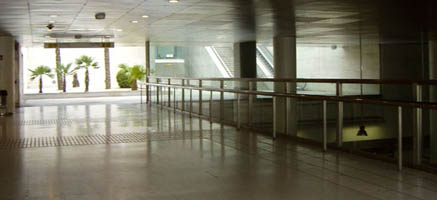
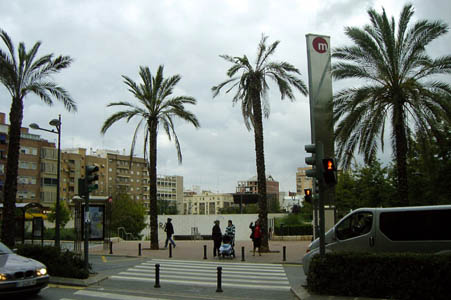
| “Valencia goes global” | |
| This issue on
recent architecture in the province of Valencia is a good opportunity for
a brief tour of the works in the city of Valencia that have ushered in the
city we know today, a far cry from the provincial capital of the 1970s. Although the world has noticed the
transformation that Valencia has undergone over the past 30 years since
its new image has been broadcast by the coverage of the latest events it
has hosted (World Meeting of Families, 32nd America’s Cup, McLaren
Mercedes launch, European Formula 1 Grand Prix venue), the seeds of its
metamorphosis lie in the 1980s, in the political changes in Spain and the
development of the system of autonomous regions. This administrative
decentralisation and devolution led to intense public building activity to
provide neighbourhoods with amenities and services: gardens, health
centres, primary schools, high schools, swimming pools, etc. The
architectural style employed was a modern mannerism with two main
currents: international minimalism and the Italian ‘Tendenza’, seen in
the City Hall annex in Avenida de Aragón and the regional government’s
Ministry of Culture and Education building. Just as the Modern Movement spread
throughout the West in the 1950s as the style of post-war reconstruction,
in the 90s a more eclectic, more easily accepted version joined the
iconography of the average Spaniard as the image of public buildings.
Nowadays it is also totally accepted in corporate buildings and private
housing developments. ARTICULATING ELEMENTS AND LANDMARKS Ricardo Bofill drew up the first Special
Plan of Interior Reform for its layout, proposing a continuous classical
garden divided into sections for staggered implementation and easier
management. He also designed sections T-10 and T-11, the classical garden
in the section by García de Paredes’ Palau de la Música that becomes a
modern agora at weekends. The rest of the garden was not executed
according to Bofill’s proposal but laid out in a more landscaped
fashion, although it was developed in stages and some included sports
facilities. Section T-1 was designed by the Vetges Tu i Mediterrània
studio. The Cabecera Park at the head of the Turia
garden is a remodelled landscape that acts as a buffer for the new zoo,
the Bioparc, while the City of Arts and Sciences stands on the southern
side of the old riverbed close to its mouth. The complex comprising the
Science Museum, Hemisférico (Planetarium), Umbráculo and Palau de les
Arts opera house was designed by Santiago Calatrava and the Oceanographic
Park jointly with Félix Candela. Leaving architectural criticism aside, the
City of Arts and Sciences as a whole and each of its buildings possess the
typical qualities of a landmark: gigantic size, strongly sculptural,
primacy of form and aesthetics, uniqueness and volumes or sections that
are easily schematised and identifiable as a collective reference point.
Their image is somewhat brutalist and highly photogenic. Although the image used to represent the
new Valencia may be the Turia gardens, the City of Arts and Sciences or
the Veles i Vents building (the America’s cup headquarters), we must not
forget all the other less dazzling works without which the unity that the
city now possesses could not have been achieved. The operation of suturing
the different fragments began with the Turia and continued by cleaning up
and reorganising the Cabañal and Malvarrosa beaches and building the
seaside promenade, placing the railway line to Barcelona underground and
building Avenida Serreria over it, with the new Cabañal railway station,
and turning the former narrow-gauge railways into tram and metro lines.
The walls came down, uniting adjoining neighbourhoods that had lived with
their backs to each other. Along with the new fast entrance and
ring-road avenues, the metro is one of the star features of the changes.
The expansion of the lines and their connections with the trams now link
the city to the airport, the port, the beach and the sea promenade. The
stations have become landmarks for their neighbourhoods: Ayora a node of
gardens, swimming pool and metro station, Serrería connecting the metro
and tram with a station and garden node. The development and renewal of part of the
surroundings entails demolitions and real estate upgrading, but the action
areas are also enriched by the facilities that the new infrastructure
brings: health centres, schools, housing, offices, etc. These buildings
enter the fabric of the city with a certain air of modernity and
renovation. The good quality of most of them must be recognised, thanks to
the efforts of the architects and the support given to architecture in
recent years by the College of Architects and the Regional Ministries of
Education, Health, Architecture and Housing and Servef, the regional
employment and training agency. The great events have accelerated the
necessary works to improve the links with the sea-front neighbourhoods and
open the city to the old commercial port. The traffic has been
reorganised, streets have been laid out, barriers such as the old fence
around the port have been removed and port buildings, sheds, quays and
docks have been refurbished and converted to urban uses and promenades, as
in the Darsena Park by Juan Añón and Rafael Martínez. All these works
serve to organise the seaward urban edge and create the maritime façade
of the city. Another of the important tasks that the
city still has to tackle is to define its landward façades, an
undertaking that is equally difficult or more so in that it also involves
setting limits that are not imposed by nature. The globalisation of the new image of
Valencia owes much to the internet, a tool that in record time, almost in
real time, places knowledge, culture and news within reach of a number of
people never before imagined. In this global world of communications, the
image of any architecture is broadcast worldwide as soon as it is
completed, or even before (virtual images, webcams following the stages of
its construction). This means that any architectural proposal or
alternative, whatever its value, joins the catalogue of styles, which are
represented by images of details that form a repertoire of ‘master’
parts which can be fitted into any building. The advantages of globalisation (immediacy and popularisation, economy and speed, freedom and communicating knowledge) must be weighed up against some drawbacks such as information overload, necessitating a selection and filtering effort, or the exaltation of facile architectural images, giving rise to the creation of “unsuitable and decontextualised stage sets”. However, these drawbacks must be considered more an incorrect use of globalisation than a problem of globalisation. This issue on recent architecture in the
province of Valencia is a good opportunity for a brief tour of the works
in the city of Valencia that have ushered in the city we know today, a far
cry from the provincial capital of the 1970s. Although the world has noticed the
transformation that Valencia has undergone over the past 30 years since
its new image has been broadcast by the coverage of the latest events it
has hosted (World Meeting of Families, 32nd America’s Cup, McLaren
Mercedes launch, European Formula 1 Grand Prix venue), the seeds of its
metamorphosis lie in the 1980s, in the political changes in Spain and the
development of the system of autonomous regions. This administrative
decentralisation and devolution led to intense public building activity to
provide neighbourhoods with amenities and services: gardens, health
centres, primary schools, high schools, swimming pools, etc. The
architectural style employed was a modern mannerism with two main
currents: international minimalism and the Italian ‘Tendenza’, seen in
the City Hall annex in Avenida de Aragón and the regional government’s
Ministry of Culture and Education building. Just as the Modern Movement spread
throughout the West in the 1950s as the style of post-war reconstruction,
in the 90s a more eclectic, more easily accepted version joined the
iconography of the average Spaniard as the image of public buildings.
Nowadays it is also totally accepted in corporate buildings and private
housing developments. ARTICULATING ELEMENTS AND LANDMARKS Ricardo Bofill drew up the first Special
Plan of Interior Reform for its layout, proposing a continuous classical
garden divided into sections for staggered implementation and easier
management. He also designed sections T-10 and T-11, the classical garden
in the section by García de Paredes’ Palau de la Música that becomes a
modern agora at weekends. The rest of the garden was not executed
according to Bofill’s proposal but laid out in a more landscaped
fashion, although it was developed in stages and some included sports
facilities. Section T-1 was designed by the Vetges Tu i Mediterrània
studio. The Cabecera Park at the head of the Turia
garden is a remodelled landscape that acts as a buffer for the new zoo,
the Bioparc, while the City of Arts and Sciences stands on the southern
side of the old riverbed close to its mouth. The complex comprising the
Science Museum, Hemisférico (Planetarium), Umbráculo and Palau de les
Arts opera house was designed by Santiago Calatrava and the Oceanographic
Park jointly with Félix Candela. Leaving architectural criticism aside, the
City of Arts and Sciences as a whole and each of its buildings possess the
typical qualities of a landmark: gigantic size, strongly sculptural,
primacy of form and aesthetics, uniqueness and volumes or sections that
are easily schematised and identifiable as a collective reference point.
Their image is somewhat brutalist and highly photogenic. |
|
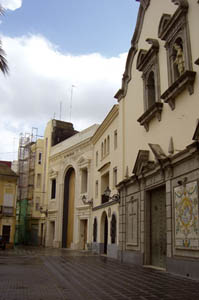 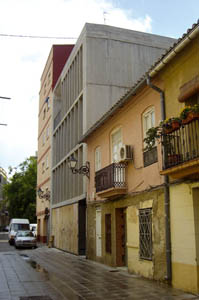 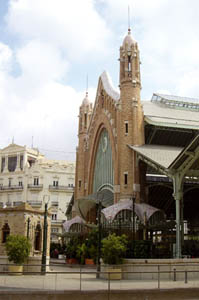 |
|
| Although the image
used to represent the new Valencia may be the Turia gardens, the City of
Arts and Sciences or the Veles i Vents building (the America’s cup
headquarters), we must not forget all the other less dazzling works
without which the unity that the city now possesses could not have been
achieved. The operation of suturing the different fragments began with the
Turia and continued by cleaning up and reorganising the Cabañal and
Malvarrosa beaches and building the seaside promenade, placing the railway
line to Barcelona underground and building Avenida Serreria over it, with
the new Cabañal railway station, and turning the former narrow-gauge
railways into tram and metro lines. The walls came down, uniting adjoining
neighbourhoods that had lived with their backs to each other. Along with the new fast entrance and
ring-road avenues, the metro is one of the star features of the changes.
The expansion of the lines and their connections with the trams now link
the city to the airport, the port, the beach and the sea promenade. The
stations have become landmarks for their neighbourhoods: Ayora a node of
gardens, swimming pool and metro station, Serrería connecting the metro
and tram with a station and garden node. The development and renewal of part of the
surroundings entails demolitions and real estate upgrading, but the action
areas are also enriched by the facilities that the new infrastructure
brings: health centres, schools, housing, offices, etc. These buildings
enter the fabric of the city with a certain air of modernity and
renovation. The good quality of most of them must be recognised, thanks to
the efforts of the architects and the support given to architecture in
recent years by the College of Architects and the Regional Ministries of
Education, Health, Architecture and Housing and Servef, the regional
employment and training agency. The great events have accelerated the
necessary works to improve the links with the sea-front neighbourhoods and
open the city to the old commercial port. The traffic has been
reorganised, streets have been laid out, barriers such as the old fence
around the port have been removed and port buildings, sheds, quays and
docks have been refurbished and converted to urban uses and promenades, as
in the Darsena Park by Juan Añón and Rafael Martínez. All these works
serve to organise the seaward urban edge and create the maritime façade
of the city. Another of the important tasks that the
city still has to tackle is to define its landward façades, an
undertaking that is equally difficult or more so in that it also involves
setting limits that are not imposed by nature. The globalisation of the new image of
Valencia owes much to the internet, a tool that in record time, almost in
real time, places knowledge, culture and news within reach of a number of
people never before imagined. In this global world of communications, the
image of any architecture is broadcast worldwide as soon as it is
completed, or even before (virtual images, webcams following the stages of
its construction). This means that any architectural proposal or
alternative, whatever its value, joins the catalogue of styles, which are
represented by images of details that form a repertoire of ‘master’
parts which can be fitted into any building. The advantages of globalisation (immediacy and popularisation, economy and speed, freedom and communicating knowledge) must be weighed up against some drawbacks such as information overload, necessitating a selection and filtering effort, or the exaltation of facile architectural images, giving rise to the creation of “unsuitable and decontextualised stage sets”. However, these drawbacks must be considered more an incorrect use of globalisation than a problem of globalisation.
|
|
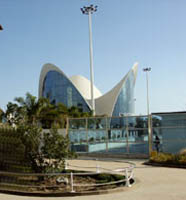 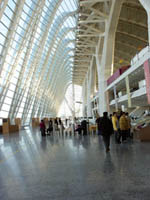 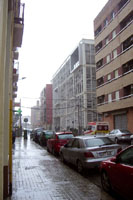 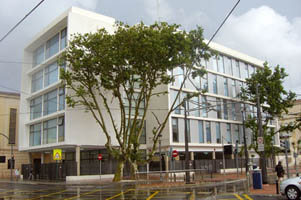 |
|
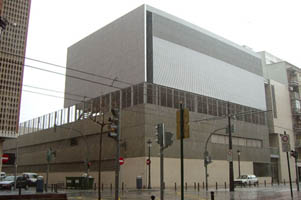 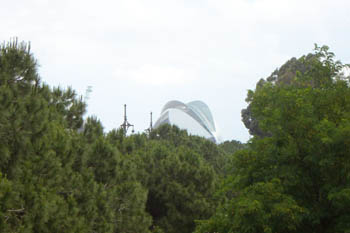 |
|